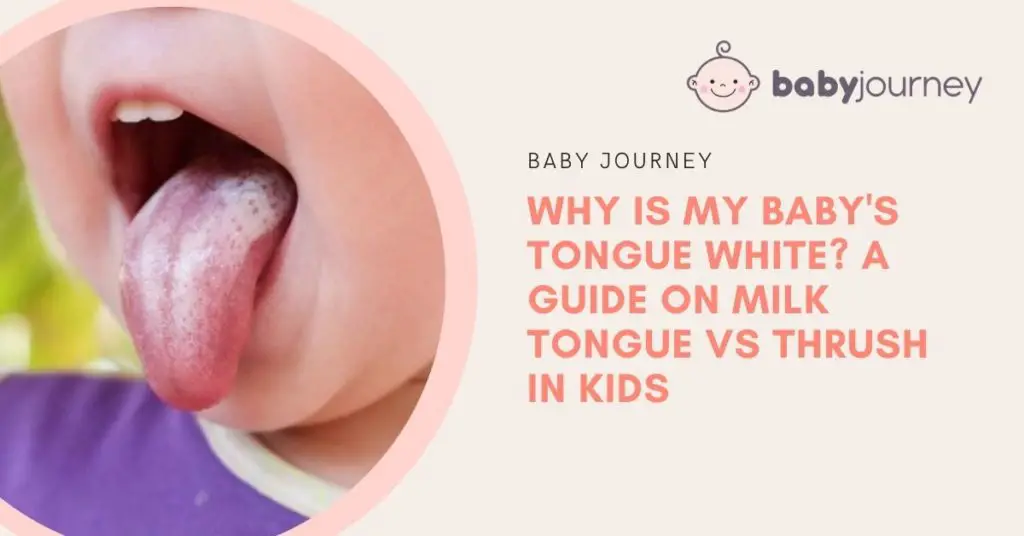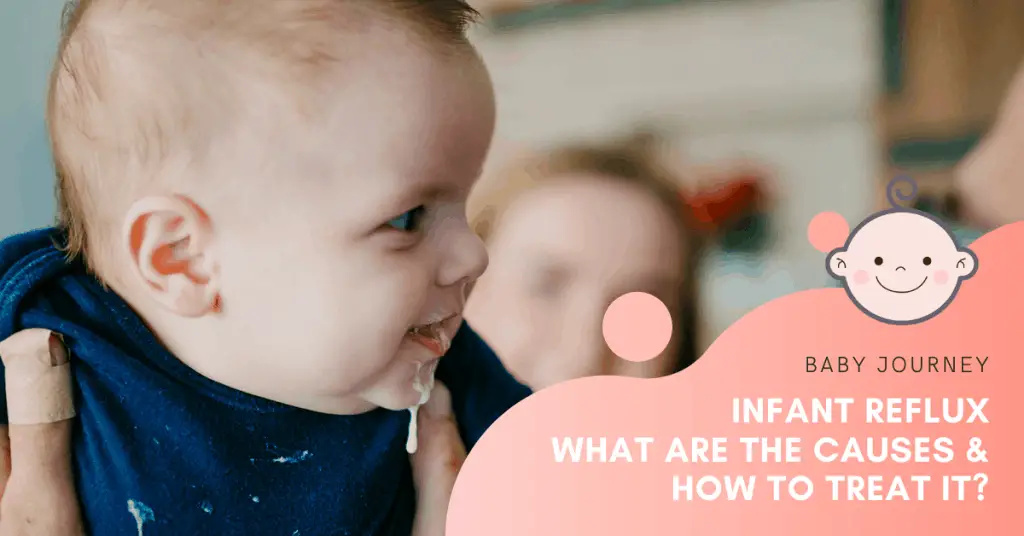You see that your baby’s tongue has white film. Is it normal for baby’s tongue to be white? Is it milk residue or thrush? Should you be concerned? Milk tongue isn’t a big deal, and no need to worry. Thrush however can be uncomfortable, hard to deal with, and usually requires treatment. Cue the worry!
Thankfully, our thrush vs milk tongue guide is here to help. We will cover both issues, helping you determine which condition your baby is experiencing when you see white tongue.
Understanding Thrush vs Milk Tongue in Babies
Before we dive into how to tell whether a baby’s white tongue is thrush or milk tongue, we need a short overview of both milk tongue and thrush.
Milk Residue on Baby’s Tongue
When your baby breastfeeds or takes a bottle of formula, milk obviously comes into contact with their tongue. When they are finished eating, you may notice a white coating on baby’s tongue. This can be milk residue on baby’s tongue, sometimes called milk tongue. If you notice your baby’s tongue is white immediately after each feeding, milk may be to blame.
Related: Formula That Taste Like Breast Milk
There are a few reasons for this milk coating. The first is that baby’s mouths do not have as much saliva as adults’ mouths. Less saliva equates to less liquid to wash the tongue of milk residue; hence the white build-up. Additionally, some babies may have a particularly hard time rubbing off the milk layer.
If your child has a hard or high palate it may be difficult for the surface of their tongue to come into contact with the roof of their mouth. When this doesn’t happen the white milk layer doesn’t get sloughed off.
Tongue ties can also restrict the tongue and not allow it to rub against the roof of the mouth. This too will mean that the white milky substance is left intact on your child’s tongue. Both of these conditions can lead to quite the stubborn milk tongue.

One key way to identify milk tongue is if the white coating wipes away easily by gently wiping with a cloth. But we’ll talk more about that later!
Milk residue white coating on tongue usually isn’t a cause for concern. If you notice it often, along with other signs or symptoms of a tongue-tie, like a difficulty breastfeeding, it wouldn’t hurt to talk to your child’s pediatrician. This is the exception though.
Most milk tongue is only temporary and doesn’t cause your little one discomfort. The older your child gets and starts producing more saliva in addition to eating solid foods and drinking liquids, the less they will experience milk tongue.
Milk Tongue Signs and Symptoms
- White residue on the tongue after feeding
- White residue is limited to the tongue only
- Does not cause the baby discomfort
- Can be wiped away with a soft cloth and the baby’s tongue will be pink underneath
Oral Thrush in Baby’s Mouth
Oral thrush [1] can also present as a white tongue on baby. Unfortunately, unlike harmless milk on baby’s tongue, untreated thrush can be a cause for concern.
What is thrush? Thrush is actually a yeast infection. It is caused when a fungus called Candida albicans grows out of control. Don’t fret, there isn’t mold on your baby’s tongue. In fact, you’ve probably heard the word, Candida, before. This is because it is the same fungus overgrowth that can lead to a vaginal yeast infection and diaper rash.
Yeast infections like oral newborn thrush occur in the mouth. Like many Candida infections, it can spread to your child’s tongue, cheeks, and lips. Unfortunately, when baby nurses, it can also spread to your nipples, especially with prolonged sucking. An overgrowth of yeast on your nipple area can cause oral thrush and vice versa.
This is why some moms become very worried when they notice their breastfed baby has white tongue or white lesions in their newborn’s mouth.
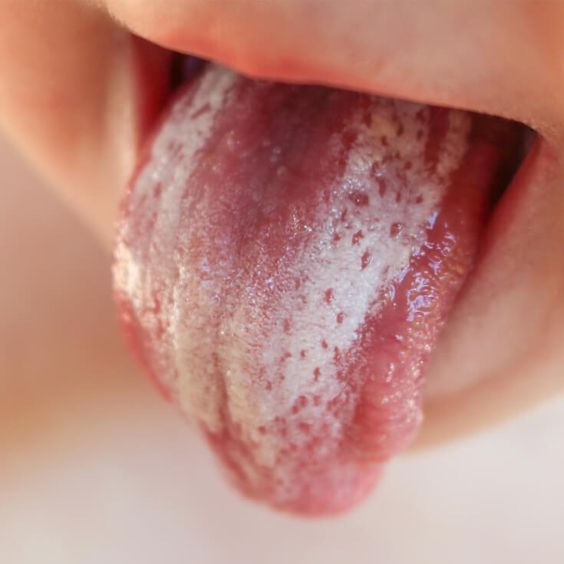
Why do babies get thrush and adults don’t? Well, their weaker immune system can play a role. However, medications like antibiotics can also be to blame. If your baby takes an antibiotic to remedy a different sickness the medication kills off both good and bad bacteria.
With no good bacteria to keep the yeast in check and prevent thrush, it goes wild, leading to newborn thrush or oral thrush in older babies. It’s important to know that both bottle-fed and breastfed babies can experience this fungus Candida white patches infection.
Sadly, oral thrush white patches aren’t as easy to deal with as milk tongue. This cottage-cheese like coating is very difficult to brush off your baby’s mouth. If your baby’s tongue is white for long periods throughout the day, it may be thrush in the mouth and not just milk.
Thrush only on a newborn’s tongue isn’t common but it can happen. In most cases, it usually spreads to other areas in the mouth besides just the child’s tongue. The worse the infection becomes the more painful it can be, leading to, you guessed it, breast milk or bottle-feeding aversion. And if the baby won’t eat and is unhappy, chances are no one else will be happy either.
Nevertheless, thrush isn’t uncommon and most doctors are prepared to deal with it. They’ll likely provide you with antifungal medication to put on your little one’s tongue. If you have thrush too from nursing, you’ll need to treat yourself as well.
Signs and Symptoms of Thrush
- The white layer won’t wipe off easily
- Spreads to tongue, inner lips, and inner cheeks, basically whole mouth involved
- Can cause pain or discomfort
- You notice the white tongue throughout the day, not just after feeding
- Mom experiences nipple thrush in conjunction
A Note About Epstein Pearls
How do you know if your child has Epstein pearls or thrush? Epstein pearls may occur anywhere in the mouth, though commonly on the palate and gums. They are small whitish-yellowish cysts. They are harmless, don’t cause discomfort, and will eventually go away.
These bumps can be quite common and don’t look like the solid milky white layer of thrush or milk tongue.
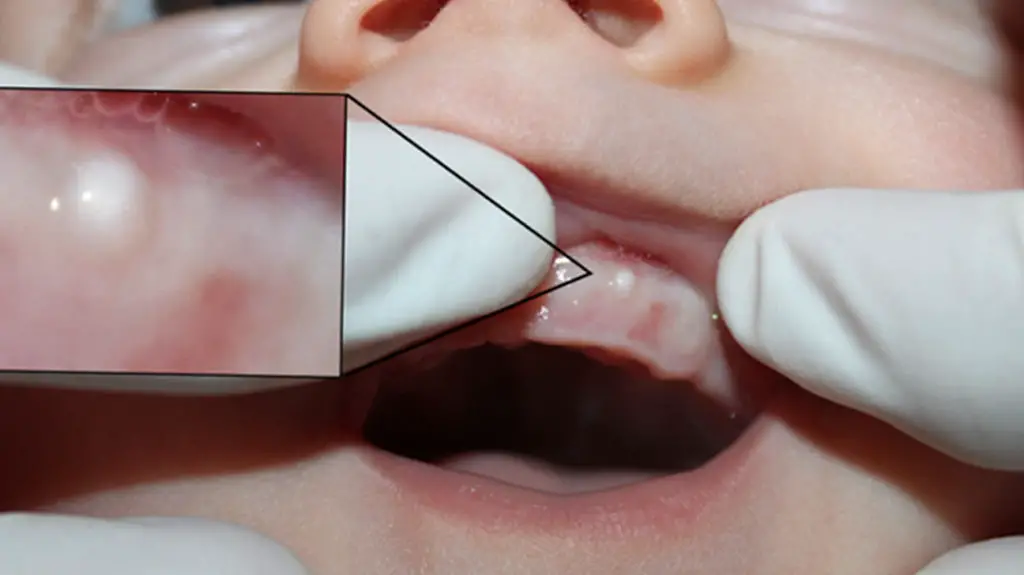
How Do I Know If My Baby Has Thrush or Milk Residue From the White Tongue?
When deliberating milk tongue vs thrush, looking at newborn thrush vs milk tongue pictures can help. But there are also a few key factors [2] that can help you know the difference between thrush and milk tongue.
The first is how easily it can be wiped away. Milk tongue can be cleaned off with a damp cloth and wiped away to show pink, healthy tongue underneath. Thrush is very hard to remove and hangs on even with scrubbing. Don’t wipe too hard, thrush can be painful. And speaking of pain, milk tongue is never painful, thrush can be.
The second is that milk tongue is commonly only on the tongue. Thrush spreads to the cheeks and lips. Additionally, if a breastfeeding mom experiences symptoms of nipple thrush then it is likely her baby has oral thrush.
Finally, the duration is important to note. Milk tongue usually only happens after feedings. Afterwards, it should slowly dissipate. A thrush infection will be noticed throughout the day.
When Is Thrush or Milk Tongue A Concern?
If you notice white stuff on baby’s tongue and think it could be thrush, it’s a good idea to see your child’s doctor. You don’t want to let the thrush get out of control. You also don’t want it to spread to you if you are breastfeeding. Furthermore, thrush can be uncomfortable, causing your child not to want to suck or eat.
Thrush can go away on its own, but it is best to let the doctor make that decision. Thrush is easily treatable but if left untreated it could end up causing your baby oral pain. Recurrent thrush can also be cause for concern and necessitate a trip to the doctor.
Your doctor may provide you with medication for such oral conditions. Or, they could suggest a home remedy like diluted baking soda. Don’t give your child anything without your doctor’s guidance.
Milk tongue isn’t usually a cause for concern though it can be alarming if your newborn has a white tongue. If you are doubtful about how to clean baby’s tongue from milk, milk tongue can be wiped away with a damp cloth, but there really isn’t a need to do this. Instead, you can let it dissipate, being washed away by your child’s saliva after each feeding.
FAQs
Can you wipe thrush off the baby’s tongue?
Thrush commonly cannot be wiped off. Not only is it stubborn but it can be painful to do so.
Can oral thrush just affect the tongue in babies?
In most cases, oral thrush is not limited to the tongue. Though it can start there it will often spread to the inner lips and cheeks inside the mouth.
Is oral thrush painful for babies? Does thrush make baby fussy?
Thrush may be painful for babies, especially if left untreated. If thrush is uncomfortable your child may become fussy, irritable, and not want to suck or eat.
Can I get thrush from kissing my baby?
The yeast fungus could pass from your baby to you if you kiss them. However, it is more common for the oral thrush to pass to the mother’s nipples if she is breastfeeding.
Will thrush go away if I stop breastfeeding? Should I continue to breastfeed if baby has thrush?
Thrush isn’t caused by breastfeeding, so there isn’t any need to stop. However, if your child has thrush and you are nursing it is important to treat both them and yourself so you do not keep passing it back and forth. Your child may not want to nurse if the thrush is painful; in which case you should use breast pumps for every missed feeding.
Milk Tongue or Thrush? Now You Know!
Hopefully, this article helped you tell the difference between baby milk tongue vs thrush!
Have you dealt with either of these issues? We would love to hear about your experience. Let us know in the comments below!
—
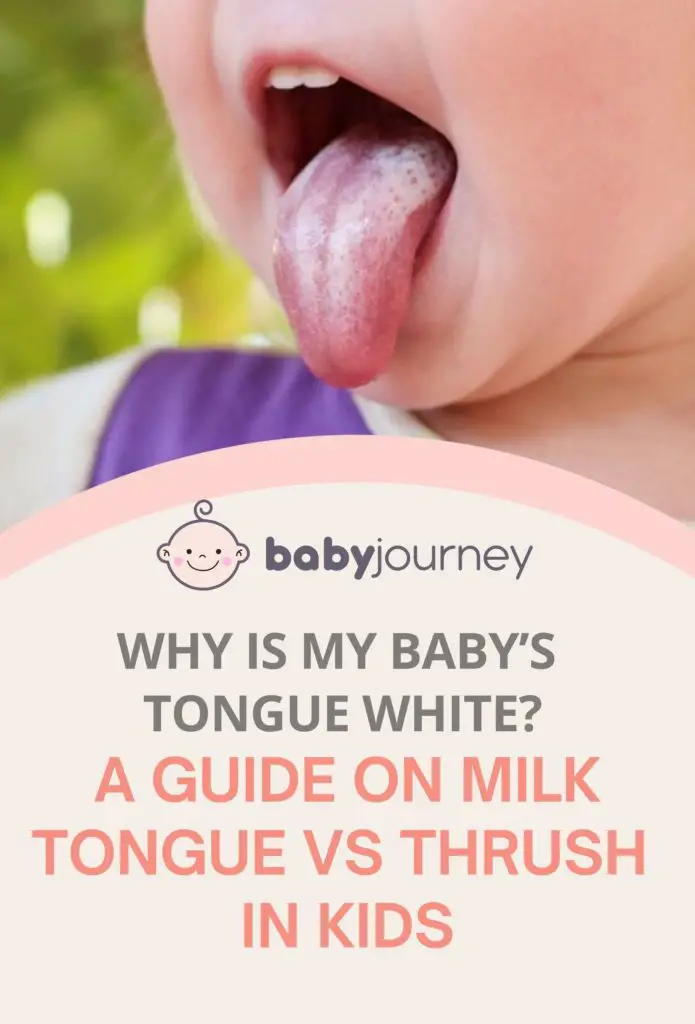
Last update on 2024-04-18 / Affiliate links / Images from Amazon Product Advertising API

